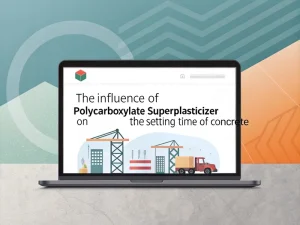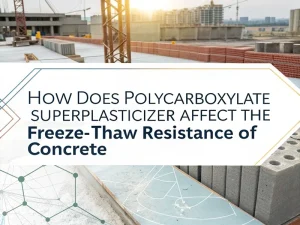
The Influence Of Polycarboxylate Superplasticizer On The Setting Time Of Concrete
Blog The influence of pol
Blog

Polycarboxylate superplasticizer is a new type of concrete additive.
1.Regarding Chemical Structure and Composition
Polycarboxylate superplasticizers have a unique molecular structure. They consist of a main chain, usually a polyethylene or polypropylene oxide chain, with multiple side chains that are carboxylic acid or carboxylic ester groups. This comb-like structure gives them excellent dispersion capabilities. The side chains interact with the cement particles, providing steric hindrance and electrostatic repulsion, which effectively prevents the agglomeration of cement particles and keeps them well-dispersed in the concrete mixture.
In contrast, naphthalene-based superplasticizers are synthesized from naphthalene and formaldehyde through a condensation reaction. Their molecular structure is more linear and lacks the complex side chains of polycarboxylate superplasticizers. Melamine-based superplasticizers are formed by the reaction of melamine and formaldehyde, and they also have a different chemical composition and structure compared to polycarboxylate superplasticizers.
2.Regarding water reduction rate
The water reduction rate of polycarboxylate superplasticizer is significantly higher than that of naphthalene superplasticizer and other superplasticizer types. Under the same water reduction rate, the dosage of polycarboxylate superplasticizer is smaller than that of naphthalene superplasticizer.
In addition, with the increase in dosage, the ultimate water reduction rate of polycarboxylate superplasticizer far exceeds that of naphthalene-based superplasticizer, and the dosage of naphthalene-based superplasticizer has exceeded the limit at around 2.0%, indicating that polycarboxylate superplasticizer is more suitable for preparing low water-cement ratio high-strength concrete.
3.Regarding the mechanism of action
The primary mechanism of action of polycarboxylate superplasticizer is spatial repulsion. In addition to spatial repulsion, it also has a strong “ball” effect of gas isolation and a reduction in solid-liquid interface energy. The mechanism of action of naphthalene-based and other water-reducing agents is mainly electrostatic repulsion, with almost no other beneficial effects on water reduction.
4.Regarding the performance
Polycarboxylate superplasticizer has strong plasticity retention and can effectively control the slump loss over time without significantly affecting the hardening time of concrete. Its strengthening effect is significant, and it has anti-shrinkage properties, which can effectively improve the impermeability and frost resistance of concrete. Compared with naphthalene-based water reducers, it can significantly enhance the durability of concrete.
5.Regarding price
Naphthalene-based water reducers are generally cheaper than polycarboxylate-based water reducers. Still, considering the dosage and effectiveness, the cost of using polycarboxylate-based water reducers may be lower.
6.Regarding environmental performance
Polycarboxylate superplasticizers are generally considered more environmentally friendly. They have a lower toxicity profile compared to naphthalene-based superplasticizers, which may contain harmful substances such as formaldehyde and sulfonates.
Melamine-based superplasticizers also have some environmental and health concerns associated with the release of melamine and formaldehyde. The production and use of polycarboxylate superplasticizers result in fewer emissions and a reduced environmental footprint, which is in line with the growing demand for sustainable construction materials.
7.Regarding cement compatibility
It is compatible with cement and other types of concrete admixtures and can produce a good additive effect when compounded with traditional high-efficiency water reducers, such as naphthalene-based water reducers.
8.Regarding fluidity
It has little effect on the setting time of cement and can effectively solve problems such as water reduction, air entrainment, relief, and bleeding. The synthesis process is simple, and the raw materials for synthesizing the polymer main chain are widely available. The monomers usually include acrylic acid, methyl acrylic acid, maleic acid, (methyl) ethyl acrylate, (methyl) hydroxyethyl acrylate, vinyl acetate, sodium allyl sulfonate, etc.
In conclusion, it has significant advantages over other types of superplasticizers in terms of dispersion performance, water reduction capacity, compatibility, environmental impact, and cost-effectiveness. Their unique molecular structure enables them to enhance the quality and performance of concrete, making them the preferred choice for modern high-performance concrete applications.

The Influence Of Polycarboxylate Superplasticizer On The Setting Time Of Concrete
Blog The influence of pol

How Does Polycarboxylate Superplasticizer Affect The Freeze-thaw Resistance Of Concrete?
Blog How does polycarboxy